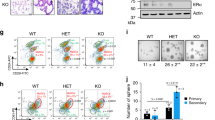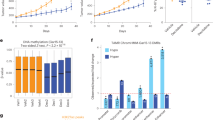Abstract
In breast cancer, approximately one-third of tumors express neither the estrogen receptor (ERα) nor estrogen-regulated genes such as the progesterone receptor gene (PR). Our study provides new insights into the mechanism allowing hormone-activated expression of ERα target genes silenced in ERα-negative mammary tumor cells. In cell lines derived from ERα-negative MDA-MB231 cells, stable expression of different levels of ERα from a transgene did not result in transcription of PR. A quantitative comparative analysis demonstrates that inhibiting DNA methyltransferases using 5-aza-2′-deoxycytidine or specific disruption of DNMT1 by small interfering RNAs and treatment with the histone-deacetylase inhibitor trichostatin A enabled ERα-mediated hormone-dependent expression of endogenous PR. We show that demethylation of a CpG island located in the first exon of PR was a prerequisite for ERα binding to these regulatory sequences. Although not a general requirement, DNA demethylation is also necessary for derepression of a subset of ERα target genes involved in tumorigenesis. PR transcription did not subsist 4 days after removal of the DNA methyltransferase blocking agents, suggesting that hormone-induced expression of ERα target genes in ERα-negative tumor cells is transient. Our observations support a model where an epigenetic mark confers stable silencing by precluding ERα access to promoters.
This is a preview of subscription content, access via your institution
Access options
Subscribe to this journal
Receive 50 print issues and online access
$259.00 per year
only $5.18 per issue
Buy this article
- Purchase on Springer Link
- Instant access to full article PDF
Prices may be subject to local taxes which are calculated during checkout







Similar content being viewed by others
References
Ahram M, Best CJ, Flaig MJ, Gillespie JW, Leiva IM, Chuaqui RF et al. (2002). Proteomic analysis of human prostate cancer. Mol Carcinog 33: 9–15.
Bachman KE, Park BH, Rhee I, Rajagopalan H, Herman JG, Baylin SB et al. (2003). Histone modifications and silencing prior to DNA methylation of a tumor suppressor gene. Cancer Cell 3: 89–95.
Balleine RL, Fejzo MS, Sathasivam P, Basset P, Clarke CL, Byrne JA . (2000). The hD52 (TPD52) gene is a candidate target gene for events resulting in increased 8q21 copy number in human breast carcinoma. Genes Chromosomes Cancer 29: 48–57.
Baron S, Escande A, Alberola G, Bystricky K, Balaguer P, Richard-Foy H . (2007). Estrogen receptor alpha and the AP1 complex cooperate during IGF-I-induced transcriptional activation of the pS2/TFF1 gene. J Biol Chem 282: 11732–11741.
Cameron EE, Bachman KE, Myohanen S, Herman JG, Baylin SB . (1999). Synergy of demethylation and histone deacetylase inhibition in the re-expression of genes silenced in cancer. Nat Genet 21: 103–107.
Dobosy JR, Selker EU . (2001). Emerging connections between DNA methylation and histone acetylation. Cell Mol Life Sci 58: 721–727.
Gerke V, Moss SE . (2002). Annexins: from structure to function. Physiol Rev 82: 331–371.
Giamarchi C, Solanas M, Chailleux C, Augereau P, Vignon F, Rochefort H et al. (1999). Chromatin structure of the regulatory regions of pS2 and cathepsin D genes in hormone-dependent and -independent breast cancer cell lines. Oncogene 18: 533–541.
Goodfellow PJ, Wells Jr SA . (1995). RET gene and its implications for cancer. J Natl Cancer Inst 87: 1515–1523.
Hamdy FC, Autzen P, Robinson MC, Horne CH, Neal DE, Robson CN . (1997). Immunolocalization and messenger RNA expression of bone morphogenetic protein-6 in human benign and malignant prostatic tissue. Cancer Res 57: 4427–4431.
Heikinheimo KA, Laine MA, Ritvos OV, Voutilainen RJ, Hogan BL, Leivo IV . (1999). Bone morphogenetic protein-6 is a marker of serous acinar cell differentiation in normal and neoplastic human salivary gland. Cancer Res 59: 5815–5821.
Jones PA, Baylin SB . (2002). The fundamental role of epigenetic events in cancer. Nat Rev Genet 3: 415–428.
Jones PA, Taylor SM . (1980). Cellular differentiation, cytidine analogs and DNA methylation. Cell 20: 85–93.
Kininis M, Chen BS, Diehl AG, Isaacs GD, Zhang T, Siepel AC et al. (2007). Genomic analyses of transcription factor binding, histone acetylation, and gene expression reveal mechanistically distinct classes of estrogen-regulated promoters. Mol Cell Biol 27: 5090–5104.
Kwon YS, Garcia-Bassets I, Hutt KR, Cheng CS, Jin M, Liu D et al. (2007). Sensitive ChIP-DSL technology reveals an extensive estrogen receptor alpha-binding program on human gene promoters. Proc Natl Acad Sci USA 104: 4852–4857.
Lacroix M, Toillon RA, Leclercq G . (2004). Stable ‘portrait’ of breast tumors during progression: data from biology, pathology and genetics. Endocr Relat Cancer 11: 497–522.
Laganiere J, Deblois G, Lefebvre C, Bataille AR, Robert F, Giguere V . (2005). From the cover: location analysis of estrogen receptor alpha target promoters reveals that FOXA1 defines a domain of the estrogen response. Proc Natl Acad Sci USA 102: 11651–11656.
Lande-Diner L, Zhang J, Ben-Porath I, Amariglio N, Keshet I, Hecht M et al. (2007). Role of DNA methylation in stable gene repression. J Biol Chem 282: 12194–12200.
Lazennec G, Alcorn JL, Katzenellenbogen BS . (1999). Adenovirus-mediated delivery of a dominant negative estrogen receptor gene abrogates estrogen-stimulated gene expression and breast cancer cell proliferation. Mol Endocrinol 13: 969–980.
Leu YW, Yan PS, Fan M, Jin VX, Liu JC, Curran EM et al. (2004). Loss of estrogen receptor signaling triggers epigenetic silencing of downstream targets in breast cancer. Cancer Res 64: 8184–8192.
Lin CY, Strom A, Vega VB, Kong SL, Yeo AL, Thomsen JS et al. (2004). Discovery of estrogen receptor alpha target genes and response elements in breast tumor cells. Genome Biol 5: R66.
Lin CY, Vega VB, Thomsen JS, Zhang T, Kong SL, Xie M et al. (2007). Whole-genome cartography of estrogen receptor alpha binding sites. PLoS Genet 3: e87.
Lopez-Serra L, Ballestar E, Fraga MF, Alaminos M, Setien F, Esteller M . (2006). A Profile of methyl-CpG binding domain protein occupancy of hypermethylated promoter CpG islands of tumor suppressor genes in human cancer. Cancer Res 66: 8342–8346.
Metivier R, Penot G, Carmouche RP, Hubner MR, Reid G, Denger S et al. (2004). Transcriptional complexes engaged by apo-estrogen receptor-alpha isoforms have divergent outcomes. EMBO J 23: 3653–3666.
Metivier R, Penot G, Hubner MR, Reid G, Brand H, Kos M et al. (2003). Estrogen receptor-alpha directs ordered, cyclical, and combinatorial recruitment of cofactors on a natural target promoter. Cell 115: 751–763.
Momparler RL . (2003). Cancer epigenetics. Oncogene 22: 6479–6483.
Nagaraja GM, Othman M, Fox BP, Alsaber R, Pellegrino CM, Zeng Y et al. (2006). Gene expression signatures and biomarkers of noninvasive and invasive breast cancer cells: comprehensive profiles by representational difference analysis, microarrays and proteomics. Oncogene 25: 2328–2338.
Ottaviano YL, Issa JP, Parl FF, Smith HS, Baylin SB, Davidson NE . (1994). Methylation of the estrogen receptor gene CpG island marks loss of estrogen receptor expression in human breast cancer cells. Cancer Res 54: 2552–2555.
Petz LN, Ziegler YS, Schultz JR, Kim H, Kemper JK, Nardulli AM . (2004). Differential regulation of the human progesterone receptor gene through an estrogen response element half site and Sp1 sites. J Steroid Biochem Mol Biol 88: 113–122.
Platet N, Cathiard AM, Gleizes M, Garcia M . (2004). Estrogens and their receptors in breast cancer progression: a dual role in cancer proliferation and invasion. Crit Rev Oncol Hematol 51: 55–67.
Pollack JR, Sorlie T, Perou CM, Rees CA, Jeffrey SS, Lonning PE et al. (2002). Microarray analysis reveals a major direct role of DNA copy number alteration in the transcriptional program of human breast tumors. Proc Natl Acad Sci USA 99: 12963–12968.
Pradhan S, Bacolla A, Wells RD, Roberts RJ . (1999). Recombinant human DNA (cytosine-5) methyltransferase. I. Expression, purification, and comparison of de novo and maintenance methylation. J Biol Chem 274: 33002–33010.
Rae JM, Johnson MD, Scheys JO, Cordero KE, Larios JM, Lippman ME . (2005). GREB 1 is a critical regulator of hormone dependent breast cancer growth. Breast Cancer Res Treat 92: 141–149.
Raynal P, Pollard HB . (1994). Annexins: the problem of assessing the biological role for a gene family of multifunctional calcium- and phospholipid-binding proteins. Biochim Biophys Acta 1197: 63–93.
Robertson KD . (2002). DNA methylation and chromatin—unraveling the tangled web. Oncogene 21: 5361–5379.
Roodi N, Bailey LR, Kao WY, Verrier CS, Yee CJ, Dupont WD et al. (1995). Estrogen receptor gene analysis in estrogen receptor-positive and receptor-negative primary breast cancer. J Natl Cancer Inst 87: 446–451.
Rountree MR, Bachman KE, Baylin SB . (2000). DNMT1 binds HDAC2 and a new co-repressor, DMAP1, to form a complex at replication foci. Nat Genet 25: 269–277.
Rubin MA, Varambally S, Beroukhim R, Tomlins SA, Rhodes DR, Paris PL et al. (2004). Overexpression, amplification, and androgen regulation of TPD52 in prostate cancer. Cancer Res 64: 3814–3822.
Sorlie T, Perou CM, Tibshirani R, Aas T, Geisler S, Johnsen H et al. (2001). Gene expression patterns of breast carcinomas distinguish tumor subclasses with clinical implications. Proc Natl Acad Sci USA 98: 10869–10874.
Suzuki M, Sunaga N, Shames DS, Toyooka S, Gazdar AF, Minna JD . (2004). RNA interference-mediated knockdown of DNA methyltransferase 1 leads to promoter demethylation and gene re-expression in human lung and breast cancer cells. Cancer Res 64: 3137–3143.
Ting AH, McGarvey KM, Baylin SB . (2006). The cancer epigenome—components and functional correlates. Genes Dev 20: 3215–3231.
Touitou I, Vignon F, Cavailles V, Rochefort H . (1991). Hormonal regulation of cathepsin D following transfection of the estrogen or progesterone receptor into three sex steroid hormone resistant cancer cell lines. J Steroid Biochem Mol Biol 40: 231–237.
Tyteca S, Vandromme M, Legube G, Chevillard-Briet M, Trouche D . (2006). Tip60 and p400 are both required for UV-induced apoptosis but play antagonistic roles in cell cycle progression. EMBO J 25: 1680–1689.
Wijayaratne AL, McDonnell DP . (2001). The human estrogen receptor-alpha is a ubiquitinated protein whose stability is affected differentially by agonists, antagonists, and selective estrogen receptor modulators. J Biol Chem 276: 35684–35692.
Yang X, Phillips DL, Ferguson AT, Nelson WG, Herman JG, Davidson NE . (2001). Synergistic activation of functional estrogen receptor (ER)-alpha by DNA methyltransferase and histone deacetylase inhibition in human ER-alpha-negative breast cancer cells. Cancer Res 61: 7025–7029.
Zhang M, Wang Q, Yuan W, Yang S, Wang X, Yan JD et al. (2007). Epigenetic regulation of bone morphogenetic protein-6 gene expression in breast cancer cells. J Steroid Biochem Mol Biol 105: 91–97.
Acknowledgements
We thank F Gannon for cell line MDA-66, F Vignon for cell line HE-5, D Trouche and members of his group for insightful discussions and assistance and D Trouche for critical reading of the manuscript. This work was partially supported by the following grants: ANR JC08_42115, La Ligue contre le Cancer, comité du Tarn and comité de Haute Garonne, INCa, contract no. PL 06-045 and Region Midi-Pyrénées.
Author information
Authors and Affiliations
Corresponding author
Rights and permissions
About this article
Cite this article
Fleury, L., Gerus, M., Lavigne, A. et al. Eliminating epigenetic barriers induces transient hormone-regulated gene expression in estrogen receptor negative breast cancer cells. Oncogene 27, 4075–4085 (2008). https://doi.org/10.1038/onc.2008.41
Received:
Revised:
Accepted:
Published:
Issue Date:
DOI: https://doi.org/10.1038/onc.2008.41
Keywords
This article is cited by
-
A novel culture method that sustains ERα signaling in human breast cancer tissue microstructures
Journal of Experimental & Clinical Cancer Research (2020)
-
HDAC inhibition does not induce estrogen receptor in human triple-negative breast cancer cell lines and patient-derived xenografts
Breast Cancer Research and Treatment (2015)
-
H2A.Z-dependent crosstalk between enhancer and promoter regulates Cyclin D1 expression
Oncogene (2013)
-
The faah gene is the first direct target of estrogen in the testis: role of histone demethylase LSD1
Cellular and Molecular Life Sciences (2012)
-
Epigenetic Therapy in Breast Cancer
Current Breast Cancer Reports (2011)



